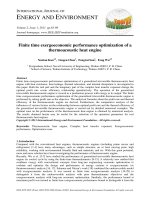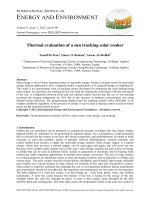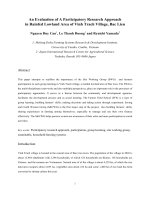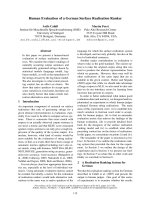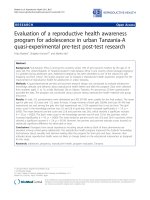Performance evaluation of a push-type manually operated garlic planter
Bạn đang xem bản rút gọn của tài liệu. Xem và tải ngay bản đầy đủ của tài liệu tại đây (269.52 KB, 9 trang )
Int.J.Curr.Microbiol.App.Sci (2020) 9(8): 2348-2356
International Journal of Current Microbiology and Applied Sciences
ISSN: 2319-7706 Volume 9 Number 8 (2020)
Journal homepage:
Original Research Article
/>
Performance Evaluation of a Push-Type Manually Operated Garlic Planter
D. K. Kushwaha1*, U. B. Singh2 and C. P. Singh2
1
Division of Agricultural Engineering, ICAR-Indian Agricultural
Research Institute – 110012, India
2
Vaugh School of Agricultural Engineering and Technology, Sam Higginbottom Institute of
Agriculture, Technology & Sciences, Formerly Allahabad Agricultural Institute, Deemed-tobe-University, Naini, Allahabad, India- 211007
*Corresponding author
ABSTRACT
Keywords
Planter, Garlic crop,
Manually operated,
Push type, Allium
sativum
Article Info
Accepted:
20 July 2020
Available Online:
10 August 2020
Garlic is a spice crop grown throughout the world. It is used all over the world as a
valuable condiment for foods. It is also known for remedy or medicine for various
ailments and physiological disorders. India is second largest producer of garlic in
the world. Garlic planting, as well as harvesting, is labour intensive operation. The
labor requirement for planting is approximately, 520 man-h/ha. Most of the
planting of garlic is done manually with the help of hand tools like khurpi.
Commercially, it is sown by the Khera method. Garlic cultivation is limited due to
excessive labor and time requirement as well as the high cost of planting.
Therefore, low cost, lightweight, and precise garlic planter is the need of the hour.
A push-type manually operated garlic planter was designed and developed. The
developed planter was evaluated in the field conditions. The performance
parameters like depth of planting, hill to hill spacing, number of seeds per hill, soil
cover over the seed, missing hills, operating distance, operating time, operating
speed, field capacity and seed rate were checked. The result of testing of the hill to
hill spacing, depth of seed placement, number of seeds per hill, soil cover over the
seed, missing hills, operating speed and field capacity were found 7.36 cm, 4.98
cm, 1.1, 4.98, 13.46%, 3.31 km/h, and 0.0367 ha/h respectively.
Introduction
Garlic belonging to the onion family, has long
been recognized all over the world as a
valuable condiment for foods. It is also
popular for remedy or medicine for various
ailments and physiological disorders. Besides,
it has insecticidal, fungicidal and bactericidal
properties too. Its regular use is known to
lower the cholesterol and blood pressure in
human body. Garlic has been cultivated for
thousands of years; Central Asia is the prime
place of its origin and the Mediterranean area
is a secondary place. Its family is
2348
Int.J.Curr.Microbiol.App.Sci (2020) 9(8): 2348-2356
Amaryllidaceae and botanical name is Allum
sativan Linn. Fresh peeled garlic cloves
(bulblets) have the following composition;
moisture: 62.8%; protein: 6.3%; fat: 0.1%;
mineral matter: 1.0%; fiber: 0.8%,
carbohydrate: 29.0%; calcium: 0.03%;
phosphorus: 0.31%; iron (Fe): 0.0001%;
calorific
value
(food
energy):
142
calories/100g; vit A: 0; nicotine acid:0.4
mg/100g: vit. C: 13 mg/100g (Pruthi, 2001).
Garlic cannot withstand too hot or too cold
weather; Short days are very favorable for the
formation of bulbs. It can be grown well at an
elevation of 1000-1500 m above the sea level.
Time of planting for garlic in plane regions is
September to November and in hilly regions
from March to May (NIIR Board, 2004).
Garlic is grown commercially in over a dozen
of states of India. The major garlic producing
states in India are Madhya Pradesh, Gujarat,
Uttar Pradesh and Rajasthan which produce
about 80% of country's total output. In year
2014-15, the three major garlic growing states
of India were Madhya Pradesh (60,000 ha),
Rajasthan (45,000 ha) and Uttar Pradesh
(37,200 ha). However, the highest
productivity was shown by Punjab (12.16
t/ha), followed by West Bengal (11.94 t/ha)
and Maharashtra (11.43 t/ha). The highest
production was recorded for Madhya Pradesh
(270,000 t), followed by Gujarat (250,000 t)
and Rajasthan (218,400 t) (NHB, 2015; Malik
et al., 2017).
In year 2015-16, the three major garlic
growing states of India were Madhya Pradesh
(80,000 ha), Rajasthan (69,100 ha) and
Gujarat (40,600 ha). The highest production
was recorded for Madhya Pradesh (450,000
t), followed by Rajasthan (377,490 t) and
Gujarat (318,200 t) (NHB, 2016).
Traditionally, the garlic sowing is performed
by khurpi or by dibbler. The seeds (cloves)
are put in the holes made by khurpi and
covered with a thin layer of soil. The garlic
cloves are sown in well prepared soil at a
depth of 5 cm with seed to seed spacing of 7.5
cm. Row-to-row spacing is kept at 10 to 15
cm.
In India, 140.3 million hectares is net sown
area out this garlic is grown in 164860
hectares. In present situation, 62.96 percent
farmers have less than four hectare plot. This
implies that these farmers are unable to
purchase costly power operated machinery
and this is uneconomical too. Hence low cost
and manual or animal operated machines have
future scope (Mahajan and Gupta, 2011).
Garlic is sown on small scale with the help of
khurpi and commercially sown by the khera
(mala bansa) method. Man power requirement
is very high for the garlic planting in
traditional methods. It requires about 60-70
persons to sow one hectare in one day
because row and plant spacing in garlic is
very narrow, that is, 15 cm and 7.5 cm,
respectively (Anonymous, 1998).
The sowing of garlic by traditional method is
highly labor intensive. Due to requirement of
high number of labor, crop sowing is delayed
in most of the cases. The standard or required
spacing between row-to-row and plant-toplant and depth of planting is not uniform. In
manual planting for larger areas, condition
like soil moisture also change rapidly and it is
not easy to hire the large number of labourers
for the planting of garlic. Planting of garlic
cloves in adverse condition will affect its
germination which will ultimately affect the
yield. Due to these reasons if the crop is
delayed, the garlic will not fetch good price in
the market.
A manually operated garlic planter has been
developed by Garg and Dixit (2003). Two
men are required one for pulling and another
for supplying the seeds. This planter does not
2349
Int.J.Curr.Microbiol.App.Sci (2020) 9(8): 2348-2356
have seed covering device, as such, the
germination was not very good. It has also
been reported that sowing depth is not
uniform. The capacity of the seed hopper is
only 3 kg due to which it requires frequent
filling. On the same principle, Singh and
Yadav (2000) also developed a manually
operated garlic planter. During operation they
found that the length of the machine was too
much and it affected the stability of the
machine. The main problem with this
machine was that the seed metering
mechanism did not meter the seed properly.
The number of seed per hill varied from 0 to
6. The machine did not have row marker due
to which there was too much variation in row
to row spacing. Garlic is a cash crop which
gives good profit to the farmers. To reduce
the labour requirement for planting operation,
it is necessary that the planters developed by
Garg and Dixit (2003) as well as by Singh and
Yadav (2000) be modified to make it
acceptable to the farmers. With this view in
mind, the planter was modified.
Materials and Methods
Considerations were made as a combined
effect of seed morphology and machine
operation. These factors are responsible for
the performance of planter. The metering
mechanism is depended on the morphology of
the seed and seed germination depends on the
quality of seed and mechanical damage
during the plantation of seed. Therefore, the
morphological properties were studied for the
development of metering system. Five
Kilograms of good quality garlic bulbs were
purchased from the local market. The size of
cloves can be defined as the maximum length,
width and thickness. These measurements
were made from a sample of 15 cloves and
replicate fifty times. The measurement was
done with the help of scale with an accuracy
of ± 0.1 mm. The size, which is represented
by length, width and thickness of garlic
cloves, varies considerably.
Keeping in view the physical properties of
garlic cloves, the components of garlic planter
were designed and developed.
Seed box
The hopper should hold approximately 12 kg
of the garlic cloves. This amount is assumed
with view that the amount should not be too
much to add excessive load on the operator or
it should not be too small, which may require
frequent filling.
The metering mechanism should be mounted
inside the hopper towards the small side of
partition created by baffle wall. The shape of
hopper should be trapezoidal for proper
installation of metering mechanism inside the
hopper.
Hence, hopper bottom was selected to be of
square shape having the sides of 20 cm. The
angle of vertical side was kept at 75° for easy
flow of cloves. The inclination is higher than
the angle of repose of the garlic cloves (32°).
A baffle wall was provided in side the hopper
to create a partition at bottom in the ratio of
3:2. The smaller portion was used to install
the occupied by metering mechanism and the
larger portion for storing the garlic cloves.
Design of baffle wall was done according to
space available in the hopper i.e. trapezoidal
and dividing ratio for seed metering device
and for storing garlic cloves. Baffle wall at
the upper side was kept 32.8 cm long,
inclined height 24.6 cm and at the bottom
10.0 cm. A hole was made of 35 cm diameter
at the center of baffle wall. Design of seed
metering covering sheet was also done
according to space available inside seed box.
The length of the sheet for covering the seed
metering mechanism was selected as 38.0 cm
and width 20.0 cm. The side view of the
planter is shown in Fig. 1. The dimensions of
seed box are also shown in Fig. 1.
2350
Int.J.Curr.Microbiol.App.Sci (2020) 9(8): 2348-2356
Seed metering mechanism
Seed tube
For the designing of cup, the length of cup
should be more than the maximum length of
cloves. The width of cup should be more than
the width of clove. The height of cup should
be slightly less than the height of clove so that
another clove cannot enter into the cup. As
reported by Singh and Yadav (2000), the
garlic cloves have length, width and thickness
as 2.99 cm, 0.9 cm and 0.9 cm respectively.
According to these dimensions of garlic
cloves the size of the seed metering cups were
selected. The length and width of cup was
kept as 3.0 cm, and 1.0 cm respectively. The
height of cup was selected as 0.5 cm (along
the length) and 0.9 cm (along the width). The
seed cup was fabricated with 1mm thick
aluminum sheet. The CAD model of seed
metering mechanism was prepared using
AutoCAD and shown in Fig. 2.
When a body falls freely downwards then the
heavier part of the body tends to come down
first and the lighter portion goes upward due
to tube surface friction. Garlic cloves are
thicker and heavier at base portion as
compared to top portion. Instead of allowing
the cloves to fall freely, if they slide along the
tube, the chances would be better that they
will fall upright in the furrow, which will help
in early germination of the garlic cloves. For
this reason, three strips of 0.5cm x 12cm x
0.5cm have been provided throughout the
length of the tube. The length of seed tube
was kept 15.5 cm, to take care of the ground
clearance of the garlic planter, and the angle
of inclination that is 30°. The strip has been
provided for the reducing the kinetic energy,
rolling force and to guide the garlic cloves.
The width and thickness of the seed tube as
40 and 4 respectively.
The eight number cups were fixed over a disc
at equal interval along the periphery. The disc
of 20 cm diameter was fabricated with mild
steel sheet of 4mm thickness.
Axle length (35 cm) and diameter (18 mm)
were kept same as provided by Singh and
Yadav (2000) as no problem was not reported
about the axle. The diameter of hub for the
seed-metering disk was kept 3.0 cm, which is
same as earlier planter.
The seed box has been divided in two parts in
the ratio of 3: 2 the smaller portion is used for
mounting the seed-metering device.
A metal strip has been put with two sides of
the seed box and baffle wall; It formed a
trapezoidal shape that will work as funnel. In
this manner the funnel was designed. The
dimension of lower portion of the funnel is 4
cm x 4 cm to allow the garlic cloves to pass
through it out any obstruction.
Furrow openers
A shovel type of furrow opener was selected
as by Singh and Yadav (2000) but slightly
modified to reduce the friction forces, as it is
cheap and simple in construction. The furrow
opener mounted on the garlic planter should
not make too narrow a furrow as it will hinder
in the placement of the seed at proper depth.
A wider furrow opener will require
unnecessary more draft. Thus, width selected
for this opener was reduced from 7.5 cm to
4.0 cm. The furrow opener was made in such
a way that it could allow the seed to fall at 5
cm depth. It was made of tool steel having a
carbon content of 0.7%. It was welded to a
curved iron strip of 50 cm length, 2.5 cm
width and 0.3 cm thickness. Ten holes were
provided on the strip for depth adjustment as
shown in Fig. 1. Another strip of same
thickness and same number of holes was
bolted at the top end of the first strip. In
addition, other end of the second strip was
2351
Int.J.Curr.Microbiol.App.Sci (2020) 9(8): 2348-2356
connected with the handle. To provide rigidity
to the furrow opener, sank was connected
with the hopper with a flat iron strip loop.
Power transmission system
To operate the metering mechanism power
was taken from the rear wheels. For the
transmission of power from the rear wheels to
metering mechanism, two sprockets were
provided and connected by means of a roller
chain. It was assumed that the metering
mechanism would have 8 cups, as more
number of cups will create problem in proper
filling. Accordingly, the speed ratio was
calculated for 7 cm seed to seed spacing.
One front wheel and two rear wheels were
provided in garlic planter. Rear wheels were
provided to give stability to machine in
stationary condition as well as for power
transmission and to maintain uniform depth of
furrow. Garlic planter is somewhat like a
hand hoe. Diameters of front and rear wheels
were selected to be 60 and 30 cm
respectively. The size of front wheel was kept
bigger than the rear wheels because the
rolling resistance is lesser for large size
wheels. Larger rear wheels, on which the seed
hopper is mounted, will raise the height of the
planter unnecessarily and it will create
problem in the stability of the planter during
operation.
Wheels were made up of flat iron strip of 2.5
cm width and 0.5 cm thickness. The length of
iron strips for front and rear wheels was 188.5
cm and 94.25 cm respectively. Sixteen lugs of
2.5 cm length, 2.5 cm height and 0.3 cm
thickness were welded on the periphery of
every each rear wheel at an equal distance of
5.88 cm. This was done to make proper grip
with the soil and to reduce the slippage. To
strengthen the wheel, eight spokes welded at
11.77 and 23.56 cm on the inner side of rear
and front wheels respectively. The other ends
of the spokes were welded on the periphery of
the hub. The mechanical clutch was provided
for switching off or on the power supplied to
seed metering device while turning in the
field. The clutch lever is provided at right side
of the handle and the clutch frog is mounted
at the side of the seed box.
Frame and handle
A hollow steel pipe with an external diameter
of 2.56 cm and 1 mm wall thickness was
selected for making the handle. This pipe was
selected, as it is easily available in the market,
light in weight, cheaper in cost and strong
enough to bear the load. One end of the
handle was attached to the front wheel for
proper guidance. In the middle, it was
connected with an iron strip, which has five
holes for adjustment of the handle to suit
operators of different heights. At the other
end of the handle a cross bar was mounted on
both ends of which proper grips were
provided to hold the planter. Two braces were
provided for connecting hopper to the front
wheel. Braces were made of iron strip having
2.5 cm width and 0.3 cm thickness.
Marker and covering device
Seed-covering device was provided for the
covering garlic cloves with the soil at a
certain depth. It was made of “Shisham”
wood that was available in the workshop. The
outer and mid diameter of the covering device
was kept 50 mm and 30 mm respectively. A
hole was provided of 20 mm diameter to
mount it on a hallow pipe.
According to data available from the
theoretical design, the drawing of all the parts
was prepared with the help of AutoCAD
2006. CAD model and fabricated garlic
planter is shown in Fig. 3. The developed
planter was tested in laboratory as well as in
field condition.
2352
Int.J.Curr.Microbiol.App.Sci (2020) 9(8): 2348-2356
Idle running of the planter was done in the
laboratory to check the working of all the
parts. Once the working of the planter was
found satisfactory in laboratory condition, it
was operated in the field. In field trial it was
observed that the garlic cloves were not
flowing freely from the seed box to the seed
metering mechanism. The hole provided for
seed flow seemed to be too small. Its size was
increased
from
103cmx100cm
to
150cmx100cm and an adjustable seed flow
controlling metal sheet was also installed for
controlling the flow of garlic cloves to the
seed-metering device. This problem was not
faced during the laboratory test. After
enlarging the opening the planter was again
checked in the field and was found that seed
flow to the metering device was satisfactory.
A bed of sand measuring 3cmx10cmx10m
was formed for allowing the cloves to fall on
this belt. The cloves will remain in place after
falling from the seed tube. The planter was
operated after removing the furrow opener
and covering device. The horizontal distance
between two adjacent seeds was measured
with the help of scale. This test was repeated
several times to minimize the error.
The seedbed for the testing of the garlic
planter was prepared with the help of spade
and khurpi for field test. The field was
divided in 5 equal size plots of 8mx3m. Type
of soil in these plots was sandy loam and the
moisture content of the soil at the time of
testing was approximately 15%. For the
performance evaluation of planter hill to hill
spacing, depth of seed placement, number of
seed per hill, soil cover over the seed, missing
hills, time taken to plant the plots, row to row
spacing and operating speed were measured.
of metering unit. It was observed that the
variation in the length was from a minimum
of 1.50 cm to a maximum of 3.30cm. The
average length of the garlic cloves was 2.31
cm. It was also observed that 71.67% cloves
were having a length between 1.9 and 2.9 cm.
The range of garlic cloves width was 0.5cm to
a maximum of 1.0 cm whereas, the mean
width of garlic clove was 0.65cm. There was
variation in thickness also which ranged from
a minimum of 0.5cm to a maximum of 1.10
cm. The average thickness of the garlic clove
was 0.67 cm. Hence it can be concluded that
there is a considerable variation in length,
width and thickness but considering the
average value into account width and
thickness were approximately the same. Thus,
the size of garlic cloves was found to
2.31cmx0.65cmx0.67cm.
The developed garlic planter was tested in
laboratory and field conditions. The data were
statistically analyzed for hill to hill spacing,
depth of planting, number of seeds per hill,
soil cover over the seed, missing hills. The
operating speed was also recorded.
The hill-to-hill distance varied from a
minimum of 6.2 cm to a maximum of 8.20
cm. The average hill-to-hill spacing of each
plot varied from a minimum of 7.00 cm to a
maximum of 7.32 cm. The average hill-to-hill
spacing was 7.36 cm as it is the average value
of the mean of 450 readings. The variation in
hill-to-hill spacing might have occurred due
to the reason that the cloves can fall anywhere
between the front and rear of the inner walls
of the seed tube. As such, a maximum
variation equal to the inner diameter of the
seed tube can be a common feature another
reason for variation in hill spacing could be
due to variation in wheel slippage.
Results and Discussion
The physical properties of the garlic cloves
were determined for the design and selection
The depth of seed placement varied from a
minimum of 3.9 cm to a maximum of 5.2 cm.
The variation was in between ±10 percent
2353
Int.J.Curr.Microbiol.App.Sci (2020) 9(8): 2348-2356
from the standard value of the depth of seed
placement of 5.0 cm. It was seen that the
maximum depth of seed placement was 5.2
cm as each individual data are the average of
seven readings. The average depth of seed
placement was 4.98 cm, which is very close
to desired depth of 5 cm. It shows that depth
of seed placement was highly satisfactory.
It was observed that the number of seeds
varied from 0 to a maximum of 3. The
number of seeds per hills, varied from a
minimum of 0.98 to a maximum of 1.2. The
average number of the seeds dropped per hill
was 1.1. Naturally the number of seeds per
hill can’t be in fraction as the average value is
a mean of a total of 450 readings; hence the
result came in fraction. The variation in
number of seeds per hill might have occurred
due to varying size of seeds.
The soil cover over the seed varied from a
minimum of 3.9 cm to a maximum of 5.2 cm.
It was observed that the average soil cover
over the seed of each plot varied from a
minimum of 4.7 cm to a maximum of 4.9 cm.
The average value of the soil cover over the
seed was 4.75 cm. The variation in soil cover
over the seed might have occurred due to
irregular topography of the land. The amount
of soil cover the seed seems to be satisfactory
as it is quite close to the desired soil cover of
5 cm.
The missing hills varied from a minimum of
10 percent to a maximum of 15.85 percent.
The average value of the missing hill was
13.86 percent missing hills might have
occurred due to not proper lifting of seeds by
the metering mechanism and improper
fabrication of the seed cups. Row to row
spacing varied from a minimum of 10 cm to a
maximum of 17.5 cm. The average value of
the row to row spacing in the plots was
15.05cm.
Garlic planter operating speed varied from a
minimum of 3.16 km/h to a maximum of 3.47
Km/h. The average value of the operating
speed in the plots was 3.31 km/h. Field
capacity varied from a minimum of 0.034
ha/h to a maximum of 0.04 ha/h. The average
value of the field capacity of all the plots was
0.0367 ha/h.
Fig.1 Side view of garlic planter
Handle
Holes provided for
depth adjustment
Frame
Seed box
Front wheel
Seed metering
plate
Furrow
opener
Rear wheels
(Dimensions are in mm)
2354
Int.J.Curr.Microbiol.App.Sci (2020) 9(8): 2348-2356
Fig.2 CAD model of seed metering mechanism prepared using AutoCAD
Cup
Disc
Hub
Front view
Side view
(Dimensions are in mm)
Fig.3 CAD model prepared using AutoCAD and fabricated garlic planter
Handle
Clutch lever
Frame
Seed box
Clutch
Rear wheel
Furrow opener
Front wheel
(a) CAD model of the garlic planter
In conclusions, the developed push type
manually operated garlic planter was
fabricated and evaluated in laboratory as well
as field condition. With the improvement in
the design of seed cups the garlic planter
worked satisfactorily in the field. It has
(b) Fabricated garlic planter
improved the seed placement significantly.
For the easy turn of the garlic planter on the
field the one wheel is freed and which
increases the performance of planter during
turning. Average number of seeds per hill was
1.11 and average hill to hill spacing 7.11 cm.
2355
Int.J.Curr.Microbiol.App.Sci (2020) 9(8): 2348-2356
Hill to hill spacing was with in ±10% which
seems to be satisfactory. Average depth of
seed placement was 4.75 cm and depth of soil
cover over the seed was 4.75 cm, both were
very near to the requirement of the garlic
cultivation. Average operating speed of the
garlic planter 3.31 km/h and operator can
walk easily behind it. Average row-to-row
spacing maintained by the garlic planter was
15.05 cm, which is close to standard
requirement of row-to-row spacing. Field
capacity of 0.0367 ha/h seems to be
satisfactory as one hectare of garlic can be
planted in 26.59 h.
References
Anonymous. 1998. Package of Practices for
Vegetable and Fruit Crops, Published
by
Additional
Director
of
Communication
for
Punjab
Agricultural University, Ludhiana,
Punjab
Agricultural
University,
Ludhiana, 40-41.
Garg, I. K., and Dixit, A., 2003. Development
and Evaluation of Manually Operated
Garlic Planter. AMA. 2(34), 19-22.
Mahajan, V., and Gupta, R. K., 2011, Non
Farm Opportunities for Smallholder
Agriculture, IFAD Conference on
New Directions for Smallholder
Agriculture, International Fund for
Agricultural Development, 5, 3-4.
Website:
/>/doc/papers/non-farm.pdf
Malik, G., Mahajan, V., Dhatt, A.S., Singh,
D.B., Sharma, A., Mir, J.I., Wani,
S.H., Yousuf, S., Shabir, A. and
Malik, A.A., 2017. Present status and
future prospects of garlic (Allium
sativum L.) improvement in India with
special reference to long day type.
Journal of Pharmacognosy and
Phytochemistry, 6(05), pp.929-933.
National Horticulture Board (NHB). 2015.
Horticulture Crops Estimates for the
Year
2015-16.
Website
link:
/>/2014-15(Final)_0.xlsx
National Horticulture Board (NHB). 2016.
Horticulture Crops Estimates for the
Year
2015-16.
Website
link:
/>/2015-16%20(Final%20Est.)_0.xlsx
NHRDF. 2010. National Horticulture
Research
and
Development
Foundation, database, garlic. Website:
/>p?DataCode=202
NIIR Board. 2004. Cultivation of Fruits,
Vegetables and Floriculture, NIIR
Board of Consultants and Engineers,
National Institute of Industrial
Research, II, 365.
Pruthi, J. S., 2001. Minor Spices and
Condiments, Bulbous Spice-Garlic,
ICAR, Krishi Anushandhan Bhavan,
Pusa, New Delhi, 85-101.
Singh, A., and Yadav, K., 2000.
Development, Fabrication and Testing
of Manually Operated Garlic Planter.
Unpublished B. Tech. Thesis,
Allahabad
Agricultural
Institute
Deemed University, Allahabad, 10-11,
21-22.
How to cite this article:
Kushwaha, D. K., U. B. Singh and Singh, C. P. 2020. Performance Evaluation of a Push-Type
Manually Operated Garlic Planter. Int.J.Curr.Microbiol.App.Sci. 9(08): 2348-2356.
doi: />
2356

